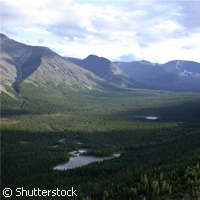Scientists shed light on solar activity and Arctic temperatures
German and Russian scientists studying tree growth on Russia's Kola Peninsula have found that while parts of the Arctic have undoubtedly cooled in the last 100 years or so, they have also warmed considerably in the last two decades. Presented in the journal Arctic, Antarctic and Alpine Research, their findings shed light on a reconstruction of summer temperatures between 1600 and 2000, generated on the base of tree rings from regions beyond the Arctic Circle. In a nutshell, solar activity plays a role in the temperatures that emerge during the Arctic's summer months. Their results show that temperatures on the Kola Peninsula during July and August fluctuated over the last 400 years. Specifically, the temperatures varied between 10.4°C (1709) and 14.7°C (1957), with a mean of 12.2°C. 'The data indicate that solar activity may have been one of the major driving factors of summer temperatures, but this has been overlaid by other factors since 1990,' said the researchers from the Helmholtz Centre for Environmental Research (UFZ), the University of Hohenheim, both in Germany, and the Russian Academy of Sciences' Institute of Geography in Moscow. For the purposes of their study, the scientists used wood samples from 69 Scots pines (Pinus sylvestris) from the Khibiny Mountains on the Kola Peninsula. The area in question is a transition zone between the Nordic region and the continent regions of Eurasia. The North Atlantic Current, a strong warm ocean current that continues the Gulf Stream - another strong, warm and swift Atlantic Ocean current - has a huge impact on the zone. It is because of this strong activity that researchers commonly launch climatological studies in the area. The Kola Peninsula is known for its cool climate, with lengthy yet moderately cold winters and cool, humid summers. The team says the mean temperature in this part of the Arctic varies between -12°C in January and +13°C in July. The growing season lasts for only 60 to 80 days, and spruce, pine and birch make up the majority of the northern taiga vegetation. The tree samples used by the team were taken from three locations in the Khibiny Mountains, at altitudes of between 250 and 450 metres above sea level, close to the altitudinal timberline. The trees here are sensitive to changes in temperature and offer researchers information they need to make correct assessments. 'Besides of temperature, growth is also strongly influenced by non-climatic factors like light, nutrients, water supply and competition from other trees,' says Yury M. Kononov of the Russian Academy of Sciences in Moscow. 'So it is vital to isolate these trends to obtain a climate goal as pure as possible.' The German and Russian scientists compared their findings with similar tree-ring studies from Swedish Lapland and Russian Siberia. They show that the reconstructed summer temperatures of the last 400 years are comparable because all the data series showed a rise in temperature in the 1950s. The Kola Peninsula is different in that it registered the highest temperatures between 1935 and 1955. By 1990, the curve dropped to the 1870 level, the period when the Industrial Age got off the ground. But data indicate that the temperatures have again been rising again in the last 20 years. 'One thing is certain: this part of the Arctic warmed up after the end of the Little Ice Age around 250 years ago, cooled down from the middle of the last century and has been warming up again since 1990,' concludes Tatjana Böttger of the UFZ.
Countries
Germany, Russia



